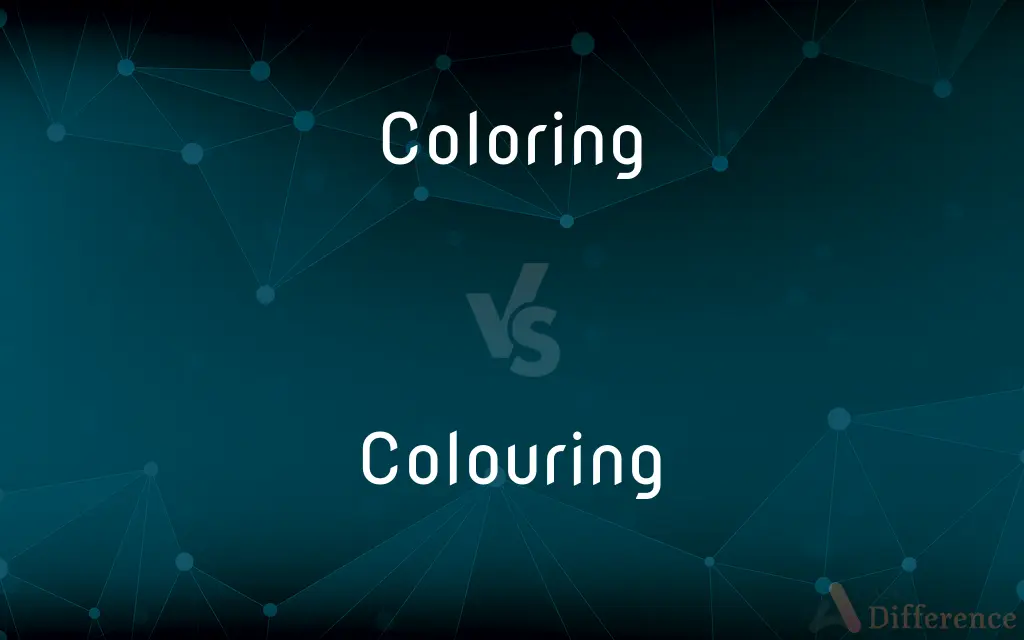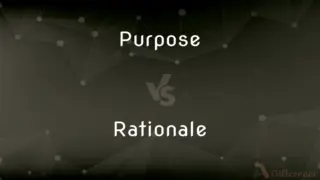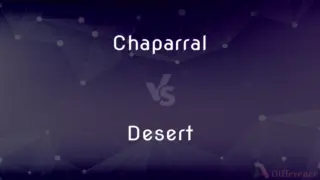Coloring vs. Colouring — What's the Difference?
By Tayyaba Rehman & Urooj Arif — Updated on March 19, 2024
"Coloring" is the American English spelling, focusing on adding color to something, while "Colouring" is the British English version of the same term, used identically in contexts like art and design.

Difference Between Coloring and Colouring
Table of Contents
ADVERTISEMENT
Key Differences
Coloring, according to American English conventions, involves the process or activity of adding color to something, such as in art, design, or digital media. It can refer to the act of filling in drawings with color, as well as the characteristic hues of an object or scene. Colouring, on the other hand, is the British English spelling of the same term. The difference in spelling does not affect the meaning or usage of the word, and both terms are used interchangeably in their respective regions.
In educational settings, coloring is a common activity for children in the United States, involving crayons, markers, or colored pencils to fill in illustrations in coloring books. Colouring serves the same purpose in countries like the UK, Australia, and Canada, where British English spelling is prevalent. This activity is recognized for its benefits in enhancing motor skills and creativity among children.
In artistic and design contexts, coloring refers to the application and theory of color in various mediums, including digital art, where software tools are used for coloring illustrations. Similarly, colouring in British English-speaking regions encompasses the same practices, with artists focusing on color choices, techniques, and effects to convey mood and style in their work.
In the culinary world, coloring (or colouring) can also refer to food coloring, which is used to alter the color of food and drinks. The term is spelled according to the regional language conventions, but the application and purpose remain consistent across English-speaking countries.
The choice between coloring and colouring often comes down to the regional or cultural preference for American or British English spelling. Writers and publishers typically adhere to the spelling norms of their target audience to ensure clarity and consistency in communication.
ADVERTISEMENT
Comparison Chart
Spelling
Coloring
Colouring
Usage
Common in the United States and countries using AmE.
Used in the UK, Canada, Australia, and other BrE regions.
Context
Art, design, education, digital media, and culinary arts.
Same as coloring, with no difference in application.
Educational Activity
Refers to children's activity of adding color to drawings.
Identical activity, with spelling adjusted for BrE regions.
Artistic Application
Involves theory and application of color.
Same as coloring, focusing on color choices and techniques.
Compare with Definitions
Coloring
The act of adding color to something, especially as an artistic activity.
The children spent the afternoon coloring in their new books.
Colouring
The process or activity of adding colour to pictures or designs.
The art class focused on colouring techniques for realism.
Coloring
A characteristic appearance resulting from the use of color.
The sunset provided a beautiful coloring to the landscape.
Colouring
The act of applying cosmetic products to enhance or change one's facial features.
She preferred natural colouring for her daytime look.
Coloring
The use of cosmetics to add color to the face.
Her makeup routine was minimal, focusing mainly on coloring her lips and cheeks.
Colouring
The appearance or effect produced by the application of colour.
The garden's colouring was most vibrant in the early morning light.
Coloring
Food additives used to change or enhance the color of food and drinks.
The recipe called for a few drops of food coloring to achieve the desired hue.
Colouring
The addition of colourants to food or drinks for visual appeal.
The chef used natural colouring derived from beetroot.
Coloring
The process of changing the color of something, such as hair coloring.
She decided to go for a bold new coloring at the salon.
Colouring
The method of altering the colour of hair, fabric, or other materials.
He was considering a different colouring for his jacket.
Coloring
The art, manner, or process of applying color.
Colouring
Alternative spelling of coloring
Coloring
A substance used to color something.
Colouring
Of something that provides colour.
Coloring
Appearance with regard to color.
Colouring
Present participle of colour
Coloring
Characteristic aspect, tone, or style.
Colouring
Same as coloring.
Coloring
False or misleading appearance.
Colouring
A digestible substance used to give color to food;
Food color made from vegetable dyes
Coloring
Present participle of color
Colouring
A visual attribute of things that results from the light they emit or transmit or reflect;
A white color is made up of many different wavelengths of light
Coloring
An act or process which applies color.
Colouring
The act or process of changing the color of something
Coloring
Any substance used to give color.
Our cookies contain no artificial flavorings or colorings.
Coloring
The appearance as to color.
Coloring
A disguise or discoloration.
Coloring
(graph theory) An assignment of a color to each vertex of a graph such that no two vertices connected by an edge are given the same color.
Coloring
The act of applying color to; also, that which produces color.
Coloring
Change of appearance as by addition of color; appearance; show; disguise; misrepresentation.
Tell the whole story without coloring or gloss.
Coloring
A digestible substance used to give color to food;
Food color made from vegetable dyes
Coloring
A visual attribute of things that results from the light they emit or transmit or reflect;
A white color is made up of many different wavelengths of light
Coloring
The act or process of changing the color of something
Common Curiosities
Is there a difference in the application of coloring or colouring in digital media?
No, there is no difference in application; both terms can be used to describe the process of adding color in digital artwork or media, depending on the regional language convention.
Is coloring or colouring used in educational activities?
Both terms are used in educational activities, such as children's coloring books, with the choice of term depending on the regional spelling conventions.
Does the choice between coloring and colouring affect meaning?
No, the choice between coloring and colouring does not affect the meaning of the term; it merely reflects the regional spelling preference.
What is the difference between coloring and colouring?
The difference is primarily in spelling, with "coloring" being the American English version and "colouring" being the British English version. Both terms refer to the same concept of adding color.
Can the term coloring or colouring be used in a metaphorical sense?
Yes, both terms can be used metaphorically, for example, to describe adding variety or interest to a situation, with the term choice reflecting regional spelling.
Do coloring and colouring have the same grammatical usage?
Yes, both terms have the same grammatical usage and can be used as nouns or verbs depending on the context, with the only difference being the regional spelling preference.
Is hair coloring or colouring popular in fashion?
Hair coloring or colouring is popular in fashion for altering one's appearance, with the choice of term reflecting the regional language convention.
How does coloring apply to art and design?
In art and design, coloring refers to the theory and application of color, including techniques, color choices, and the impact of color on compositions.
Can coloring or colouring refer to food additives?
Yes, both terms can refer to food coloring or colouring, which are additives used to change or enhance the color of food and drinks.
Are there cultural differences in the use of coloring or colouring?
Cultural differences in the use of coloring or colouring mainly relate to spelling conventions, not to the practices or concepts associated with the terms.
Are there specific coloring techniques in visual arts?
Yes, there are various coloring techniques in visual arts, such as shading, blending, and layering, applicable regardless of the spelling convention used.
Can coloring or colouring involve the use of cosmetics?
Yes, both terms can involve the use of cosmetics to add color to the face, such as blush or lipstick, with the term choice depending on regional spelling.
How do artists choose colors or colours in their work?
Artists choose colors or colours based on various factors like mood, symbolism, and visual harmony, with the choice of term depending on spelling conventions.
How do regional spelling conventions affect publishing?
Regional spelling conventions, such as the use of coloring or colouring, affect publishing by dictating the spelling used in written materials to cater to the target audience.
Share Your Discovery

Previous Comparison
Purpose vs. Rationale
Next Comparison
Chaparral vs. DesertAuthor Spotlight
Written by
Tayyaba RehmanTayyaba Rehman is a distinguished writer, currently serving as a primary contributor to askdifference.com. As a researcher in semantics and etymology, Tayyaba's passion for the complexity of languages and their distinctions has found a perfect home on the platform. Tayyaba delves into the intricacies of language, distinguishing between commonly confused words and phrases, thereby providing clarity for readers worldwide.
Co-written by
Urooj ArifUrooj is a skilled content writer at Ask Difference, known for her exceptional ability to simplify complex topics into engaging and informative content. With a passion for research and a flair for clear, concise writing, she consistently delivers articles that resonate with our diverse audience.













































